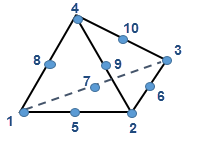The Result Options PropertyManager allows you to set result options for static, linear dynamic, nonlinear studies, and thermal transient studies.
Quantities to Save into File
Available for static studies only.
| Stresses and Strains |
When selected, the program stores the stress and strain
results in the results file (*.CWR). When this option is cleared, the program
calculates and saves only displacement and body force results. The default option for the solver is to
calculate and store all the results.
Clear this option, if you want to run a fast
analysis to view displacement results of your model, and save
disk storage space.
|
| For all
solution steps |
When selected, the program saves
the results at all solution steps. |
| For
specified solution steps |
When selected, the program saves
the results at solution steps specified in sets. |
Quantity
Available for linear dynamic studies only. Results of the following quantities
are saved in the results file (*.CWR) when selected:
| Displacements and velocities |
|
Relative
|
(Relative to the base. Applicable to
linear dynamic studies with uniform base excitation.)
|
|
Absolute
|
If you apply selected base
excitation, results are reported always in absolute
values.
|
|
| Stress
and Reactions |
Results for all stress components are available for
plotting, and the reaction forces are available for listing. For random vibration studies, the RMS and PSD
stress values are saved in the results file
*.CWR.
|
| All stress
components |
Results for all stress components are available for
plotting. |
| Nodal von Mises stress
only (Faster) |
Reduces the file size of analysis results for linear
dynamic studies. Only the von Mises stress component is available
for plotting. For random vibration studies, the
RMS and PSD von Mises stress values are saved in the results
file *.CWR.
|
| Average stresses at mid-nodes
(high-quality solid mesh only) |
Averages the stresses at mid-side nodes of high-quality solid elements
that are located at areas with steep curvature. For a
high-quality solid element, the software calculates the stresses
at the mid-side nodes by averaging the stress values at the
adjacent corner nodes. This stress averaging method improves the
calculation of stresses at mid-side notes of tetrahedral
elements with high aspect ratios.
|
 |
Example of stress averaging:
- Stresses at corner nodes (1, 2, 3, and 4)
globally averaged over the shared elements.
- Stresses at mid-side nodes (5, 6, 7, 8, 9,
and 10) averaged over the associated corner nodes. For
example, stress (node 5) = (stress (node 1) + stress (node
2)) / 2
|
Acceleration quantities are always absolute. Nonlinear dynamic studies always save relative displacements and velocities.
Solution Steps - Set 1
Appears if For specified solution steps is selected.
| Start |
The first solution step
number. |
| End |
The last solution step
number. |
| Increment |
Solution step increment. |
Solution Steps - Set 2
Appears if Solution Steps - Set 1 is selected. You can specify up to five sets.
Locations for Graphs
Appears if For specified solution steps is selected. Select vertices and reference points to save the results. Results are saved at every solution step.
If you do not select at least one entity, the results are saved for all nodes.
| For all
solution steps |
When checked, the program saves
the results at all solution steps. |
| For
specified solution steps |
When checked, the program saves
the results at solution steps specified in sets. |
Mode Selection
Available for linear dynamic studies only (time history, harmonic, and random vibration).
| All
modes |
When selected, all the available
normal modes participate in the dynamic solution. |
| Selected modes |
When selected, you can choose the
normal modes you want to include in the dynamic solution. |